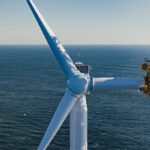A bill signed on Thursday by New Jersey’s Governor Chris Christie seeks to meet targets established in the state’s Energy Master Plan for the development of 3,000 MW of offshore wind by 2020.
The Offshore Wind Economic Development Act establishes an offshore wind renewable energy certificate program that makes available financial assistance and tax credits from existing programs for businesses that support the development of qualified offshore wind projects.
The bipartisan bill also directs the New Jersey Board of Public Utilities (BPU) to develop a program that calls for a percentage of electricity sold in the state to be from offshore wind energy. This percentage would be developed to support at least 1,100 MW of generation from qualified offshore wind projects, the governor’s office said on Thursday.
The New Jersey bill follows key approvals for the proposed Cape Wind project in Massachusetts, a project that has encountered numerous legal challenges, but which is widely seen as the first possible offshore wind farm in the U.S. New Jersey lawmakers last week said that the state was looking to boost its status as “national leader in solar energy production” and lead the U.S. charge on offshore installations.
"The disaster in the Gulf of Mexico opened our eyes to the need for clean, sustainable energy that we can produce here at home. Not only will this law make New Jersey even more energy independent, it will also bring vital new jobs to the state at a time when we need them the most,” said the state’s Senate president, Stephen Sweeney (D-Gloucester/Cumberland/Salem).
In June, Governor Christie signed a Memorandum of Understanding with other nine other East Coast governors establishing the Atlantic Offshore Wind Energy Consortium to facilitate federal-state cooperation for commercial wind development on the Outer Continental Shelf off of the Atlantic coast.
According to the governor’s office, three of the first five "interim policy leases” approved by the federal government to explore offshore wind projects are for tracts located off the coast of New Jersey. Meanwhile, the BPU has already reportedly received proposals from four power companies to build wind turbines 12 to 20 miles off the coast.
Analysts conclude that the bill will boost U.S. development of offshore wind energy, but the sector will continue to struggle with setbacks, particularly project financing.
Last week, Duke Energy Carolinas said it would no longer pursue a plan to put up to three demonstration wind turbines in the Pamlico Sound off the coast of North Carolina—a project announced barely a year ago. The purpose of the pilot project was to study the potential for coastal wind generation off the coast of North Carolina.
The company said that “in-depth analysis and engineering” showed that fixed costs associated with “permitting, design and construction of the small-scale coastal wind demonstration project were no longer economically viable.”
Instead, the company and the University of North Carolina at Chapel Hill will refocus their collaboration to study and help enable large-scale offshore wind development on the ocean side of the North Carolina coast.
“As the team tackled this first-of-its-kind project, we realized that encouraging large-scale development of offshore wind resources is a better approach than enabling small demonstration projects that lack economies of scale,” said Paul Newton, senior vice president of strategy for Duke Energy’s franchised businesses. “The cost of the project simply exceeds the benefits our customers would receive if we were to continue.”
The relatively high fixed cost of developing, permitting, and installing the first turbine makes a small demonstration project much less cost-effective than a large-scale project. For example, the Duke Energy team determined the cost of the first turbine to be $88 million, while the second turbine would cost $14 million.
Duke Energy said that additional challenges included the need to use modified shallow water construction techniques and a “greater than expected potential of disturbing underwater vegetation.”
“The work completed on this project was successful in showing that North Carolina is well positioned to develop offshore wind generation, and we encourage state lawmakers to consider legislation to enable affordable large-scale wind generation off the coast,” Newton added, however.
Sources: Office of the Governor of New Jersey, Duke Energy, POWERnews









